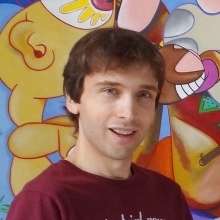Éric Bourdon
| Éric Bourdon | |
|---|---|
 | |
| Born |
1979 France |
| Nationality | French |
| Occupation | Painter and writer |
Éric Bourdon (born in 1979) is a French painter and writer.
Painting career
Bourdon's works have in common vivid colors and unpremeditated pencil strokes, expressive of raw enthusiasm in the "art brut" or "Outsider Art" manner. Paul Masquelier, critic for the controversial review Eléments [1] has pointed out the narcissistic or regressive aspects of his paintings, while noting their social commentary and the feeling of joie de vivre they convey.[2] However, the core of his artistic practice is elsewhere. Bicha Gallery outlined it as follows: "Eric's work is more drawing than painting. It is a game with lines, first drawned in a spontaneous manner, random – much like a child doodling – then worked and reworked again and again until something new, a precise figure, character, emerges from this chaos. Always newness created from the nothingness. No character ever appears twice."[3]
Writing career
Bourdon wrote a book of philosophy in 2000[4] about artistic creation in practice. He wrote a long article for the magazine Concepts 1, comparing the first ethnological discoveries of L. Ron Hubbard, later the founder of the Church of Scientology, to Zarathustra by German philosopher Friedrich Nietzsche.[5]
Six years later he published a dark psychological thriller, Les Voleurs d'Enfant (The Child Thieves),[6] depicting a cult against the cults. Although set in Boston, it is a dig at the French associations claiming religious neutrality and opposition to cults while behaving the same way as the cults they denounce.[7]
Les Clarificateurs (The Clearers),[8] released on January 2012, is a more literary sequel to Les Voleurs d'Enfant, well received by critics.[9] [10] However, as the thriller seems to explore the family reasons that lead someone to enter into a very modern religious organisation, it might be seen this time again as a complete parody of these views and a critic of the failure of the modern society.[11]
Books
- Hors-sujets, ou l'art du néant et rebonds philosophiques ("Beside the Point, or the Art of Nothingness and Philosophical Rebounds"), Sils Maria asbl, February 2000.
- Introduction to Nietzsche's "Also Spratch Zarathustra", in Concepts [1], Sils Maria asbl, August 2000, pp 91–108.
- Les Voleurs d'Enfant (The Child Thieves), La Méduse, Lille, August 2006.
- Les Clarificateurs (The Clearers), La Méduse, Lille, January 2012.
References
- ↑ Eléments is one of the reviews of the Groupement de recherche et d'études pour la civilisation européenne.
- ↑ Paul Masquelier, Eléments (#119), January 2006.
- ↑ Bicha Gallery, London, 2011.
- ↑ Sils-Maria (Belgium) publishers.
- ↑ Sils Maria Publishers.
- ↑ 'Editions de la Méduse' (Lille, France).
- ↑ Official presentation page of the novel Les Voleurs d'Enfant.
- ↑ 'Editions de la Méduse' (Lille, France).
- ↑ Lydia Bonnaventure literary criticism website.
- ↑ Critic by Thibault Isabel, writer and editor in chief of the French review Krisis.
- ↑ Official presentation page of the novel Les Clarificateurs.
External links
- (English) official website
- (French) official website